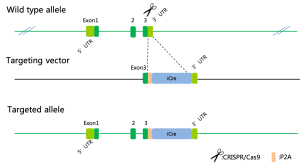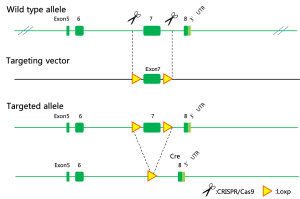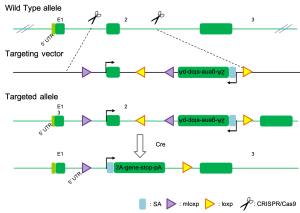Researchers use gene-edited mouse models to study gene expression, investigate genetic diseases, conduct preclinical drug efficacy tests and more. In many studies, a mouse model will harbor a gene mutation throughout its development and life, necessitating an inducible or conditional disease mouse model when researchers need more control over gene expression.
All conditional disease models utilize the Cre recombinase protein, which mediates a tissue specific deletion of DNA fragments that are flanked by loxP sites. Conditional mouse models derived from these Cre mice lines express Cre recombinase under the control of a tissue specific gene promoter. In other words, the Cre mouse model allows tissue specific gene modification based on promoter activation. The LoxP mouse line has two loxP elements flanking the entire or part of the gene of interest, giving the loxP mouse defined gene(s) to be edited.
Cre (ERT2) Inducible Mouse Model
The inducible analog of Cre is ERT2-Cre-ERT2. The ERT2 sequence is an estrogen receptor targeting motif, whose nuclear translocation and activity are controlled by an estrogen receptor modulator. Thus, administration of an estrogen receptor modulator enables inducible, temporal control of Cre activity and gene deletion.
Conditional Knockout (cKO)
In conditional knockout mice, the gene of interest is deleted only in selected cells, as determined by a tissue specific promoter. Conditional knockout mice are usually generated using Cre-LoxP, Dre-Rox or Flp-Frt recombination systems for permanent gene alterations in specific tissues. A conditional knockout (cKO) model is generated via several steps, using Cre-LoxP system as an example:
The targeted fragment to be knocked out is flanked by LoxP elements. Floxed mice are then bred with tissue-specific Cre or CreERT2 mice, and sequences between LoxP sites will be removed from the offspring’s genome in a spatial and/or temporal manner.
Conditional Knockin (cKI)
In a conditional knockin (cKI) mouse model, mice containing a floxed (or conditional) allele are crossed with Cre-expressing mice, allowing for tissue-specific expression of any exogenous elements, including mutation, reporter, etc. Conditional knockin mice are usually generated using either FLEx (Flip Excision) approach (also known as dual-lox system) or minigene system. After Cre-lox recombination by having conditional knockin mice bred with tissue specific Cre or CreERT2 mice, the mutation/reporter will be expressed in a spatial and/or temporal manner.

Request a Quote
Contact us today to find out how we can help advance your research with custom generated rat, mouse or cell line models.





